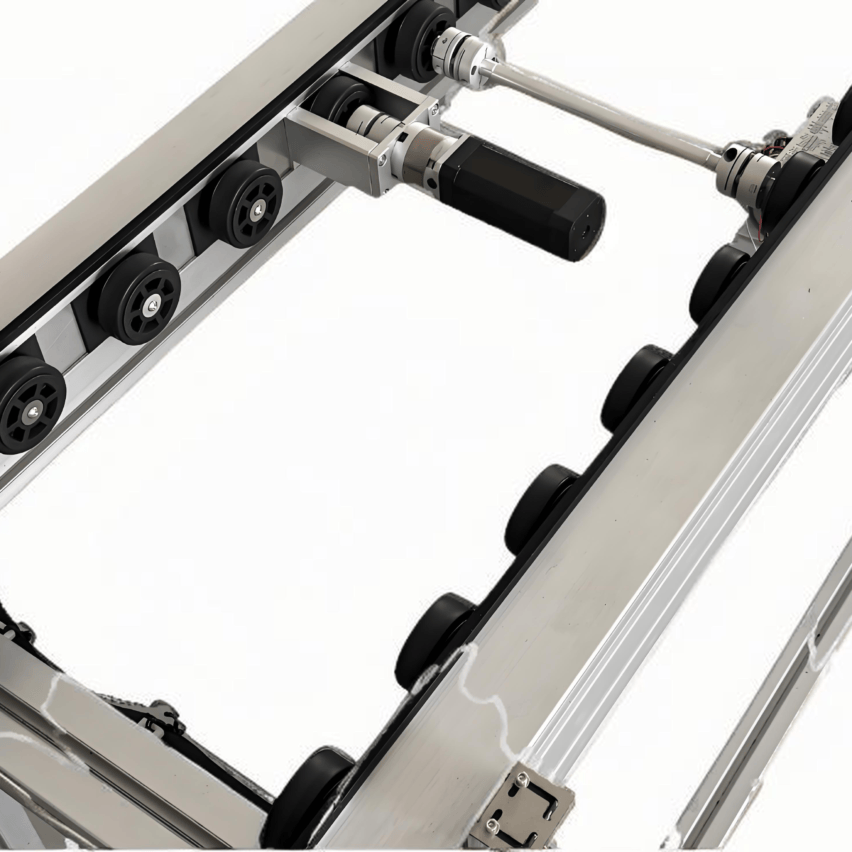In Yunnan, a pharmaceutical logistics centre, the daily average of tens of thousands of pieces of medicine due to frequent failures of the belt conveyor line leading to stranded, a single month of downtime as high as 279 times - this is not only a pain point in the logistics industry, but also the manufacturing industry is generally faced with the efficiency of the dilemma. How to make the belt conveyor line from the "failure-prone area" into a "capacity engine"? This article will be combined with industrial field practice, revealing the core methodology of belt conveyor line performance improvement.
First, the structure of the belt conveyor line: the four core modules of efficient operation
Power and Drivetrain
The drive unit (motor + reducer + drive drum) is the "heart" of the system. Automotive manufacturing lines useDual drive drum set(Load-bearing 2 tonnes/section), guaranteeing 24-hour continuous operation of heavy bodywork. The key breakthrough lies in the friction transmission design - by increasing the wrapping angle of the transmission pulley to 210°-350°, the coefficient of friction is raised to 40%, which completely solves the problem of belt slippage. The choice of material directly affects the life: food industry withFood Grade Stainless Steel RollerTo meet hygiene standards, the chemical industry requiresTeflon coated rollersResist corrosion.
Intelligent Control System
PLC and sensors build a "nerve centre". In the case of a harbour terminal renovation, the PLC and sensors are used to build a "nerve centre".Dynamic Flow Monitoring SystemBalancing loads, sorting lanes full downtime reduced from 417 minutes/day to 23 minutes. Cutting-edge programmes have been integrated intoRFID material traceabilitytogether withAI dynamic schedulingThis has reduced the misrun rate from 0.81 TP3T to 0.051 TP3T.
Modular Architecture Design
for airport baggage sorting linesModular Drum ChannelQuickly expandable to cope with peaks in passenger traffic. The support structure uses standardised components:
- Carbon steel frame with IP65 protection components for dusty environments
- Telescopic body design, length freely adjustable up to 200%
- Frequency conversion speed control technology (0.1-10M/min), accurately matching different material flow rates.
Second, industry pain points crack: six scenarios optimisation programme
| take | Traditional Pain Points | Innovative programmes | case study |
|---|---|---|---|
| quarrying | Ore impacts cause belt tears | Steel cord conveyor belt + buffer rollers | Extension of service life to 3 years |
| pharmaceutical cold chain | Shock damage to medicines in transit | Silicone covered roller + shock absorbing base | Breakage rate from 1.2% → 0.1% |
| food and drink | Bottles and cans fall over and contaminate the production line | Seamless welded body + frequency conversion speed control | Bottle loss rate of filling line from 3%→0.5% |
| port logistics | Inefficient cargo handling | Bi-directional telescopic belt conveyor + dynamic weighing | Loading and Unloading Efficiency Improvement 200% |
| rubbish disposal | Corrosive liquid erosion equipment | Explosion-proof motor + leak detection emergency stop | Reduced maintenance costs 65% |
| automobile manufacturing | Heavy parts handling damages belts | Aramid fibre reinforced tape + cushioning positioning | Reduction in line change time to 15 minutes |
Third, the failure rate to reduce the actual combat: three-step transformation method
Case: Renovation of a coal terminal with an annual throughput of 8 million tonnes
Problem diagnosis: Belt slippage rate exceeded 12%, with an average of 3 breaks per month and 25% of rollers damaged.
-
Drivetrain upgrades
- replacementsClevis belt driveReplacement of traditional flat belts with improved friction 70%
- The drive roller is coated with rubber and the coefficient of friction is increased from 0.25 to 0.4.
- mountingLaser AlignerElimination of pulley axis deviation (≤0.1mm/m)
-
Intelligent Monitoring Deployment
Establish a predictive maintenance system:- Piezoelectric tension sensor monitors belt tension fluctuations in real time
- Infrared thermal imaging camera detects abnormal drum temperature (temperature difference >15℃ is a warning)
- X-ray wire rope core inspection system (accuracy 0.5mm)
-
Total Life Cycle Management
- Establishment of the "Three Checks, Three Tights" system: daily tension checks/weekly fasteners/monthly parallelism checks
- Self-repairing rubber with microcapsules, automatically repairs cracks when they extend to 50μm.
- Establishment of a wear and tear database and BP neural network prediction of remaining lifetime
Effectiveness of transformation: Failure downtime reduced by 92%, energy consumption reduced by 35%, annual savings in maintenance costs of more than a million.
IV. Technology frontiers: from mechanical drives to intelligent systems
As the wave of Industry 4.0 sweeps across the globe, belt conveyor lines are undergoing three major transformations:
- Digital twin applications: A car company builds virtual models and optimises transport parameters in 100,000 simulations
- Energy Recovery Breakthrough: Piezoelectric Fibre Reinforced Tape Converts Mechanical Energy into Electrical Energy, Generating Power with an Efficiency of 5%
- Material Revolution: HNBR heat-resistant rubber (120°C) + nano-SiO₂ reinforcement, heat aging coefficient down to 0.003/day
Industry Insight: The value of belt conveyors extends beyond material handling. In the programmes of headline companies such as Vitrans Wei ChuangCustomised Intelligent Conveyor Systemsis becoming the core infrastructure for flexible manufacturing. Competitiveness in the future is not about the number of devices, but about how every metre of belt can be transformed into a data asset.
Self-questioning on core issues
Q: How to choose the right belt material?
A: The key depends on the application scenario:
- Food and medicine: food grade PU tape (non-toxic and easy to clean)
- Mining and metallurgy: steel wire rope core rubber belts (impact resistant)
- Chemical environment: Teflon coated tape (corrosion resistant)
- High-temperature scenario: HNBR heat-resistant tape (120°C continuous operation)
Q: What signals indicate impending belt failure?
A: Focus:
❶ Belt runout exceeds bandwidth 5%
❷ Delamination and debonding at joints
❸ Surface cracking density >0.5 bars/mm²
❹ Drive motor current fluctuation over ±15%
Q: How do I balance the tension?
A: The Golden Rule:
- Initial tension = 1.5 times minimum transmission tension
- Sag control at 2%-5% of bandwidth
- The use of laser tensiometers ensures that the deviation is <±3%.













